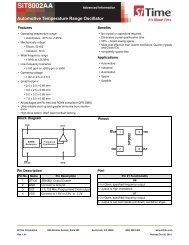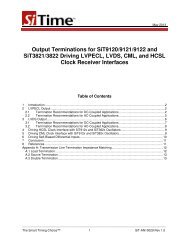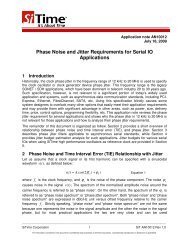<strong>Output</strong> <strong>Terminations</strong> for SiT9102/9002/9103<strong>LVPECL</strong>, <strong>LVDS</strong>, CML, and <strong>HCSL</strong> differential driversFor <strong>SiTime</strong> <strong>LVPECL</strong> current drivers, output impedance is in the range of several K-ohms whileZ o is close to 50Ω for most traces and cables. This results in a source reflection coefficient ( ΓS)close to 100% (see Appendix A), thus reflecting back virtually all of the signal that has beenreflected from the load. Fortunately, the round-trip reflection signal is small because themajority of the signals will be absorbed by the load due to its low reflection coefficient ( Γ ).In applications where a separate termination voltage is not readily available, pull-up and pulldownresistors forming a Thevenin Equivalent network can terminate the 50Ω transmission line.Such a network effectively establishes a 50Ω impedance to the termination voltage of VDD-2Vat the receiver. This termination method is shown in Figure 3; note that the resistor values aredifferent for 3.3V and 2.5V supply voltages. As in Shunt load termination, the AC-coupledcapacitors may used between the termination network and the receiver where needed.LFigure 3: LEVPECL DC-coupled load termination with Thevenin Equivalent networkOUT+<strong>LVPECL</strong>1Y-Bias TerminationnetworkZo = 50Ω0.1μFD+OUT-Zo = 50Ω0.1μFD-VDDR1R2R3R1R23.3 V2.5 V50 Ω50 Ω50 Ω50 Ω50 Ω18 ΩC10.1μFR3Figure 4: <strong>LVPECL</strong> with Y-Bias terminationIn most case the Thevenin Equivalent termination works well, but it can be sensitive to thepower supply noise if there is any significant mismatch between traces or between the resistornetworks on each side of the differential pair, or if the receiver is too sensitive to common-modenoise. Figure 4 shows the Y-Bias termination network, which provides an effective terminationvoltage of VDD-2V without requiring either connection to VDD or access to an additionaltermination voltage source. The termination voltage is generated by the sum of differential pair--------------------------------------------------------------------------------------------------------------------------------------------The Smart Timing Choice 4 SiT-AN10009 Rev 1.3
<strong>Output</strong> <strong>Terminations</strong> for SiT9102/9002/9103<strong>LVPECL</strong>, <strong>LVDS</strong>, CML, and <strong>HCSL</strong> differential driverscurrents passing through the R3. The capacitance C1 is used to create AC ground at thetermination voltage. As in previous cases, the AC-coupled capacitors may be used between thetermination network and the receiver where needed.Parallel load termination may not provide the best signal integrity for some <strong>LVPECL</strong>applications, including the following cases:1. When it is difficult to place the termination network close to the receiver, i.e., within 0.1into 0.3in from the receiver. In such cases, the traces connecting the termination networkto the receiver will appear as a stub and will degrade signal integrity at the receiverinputs.2. When there are large capacitive loads at the receiver inputs. Such capacitive loads willreduce the termination impedance when the fast edges of the signal reach the receiver,causing a large load reflection coefficient. This reflection will return to the load with littleattenuation after being reflected at the source. The rule of thumb is that the terminationmismatch becomes significant if 3.Tr/( π . CL) is less than 50Ω, where Tris the 20%-to-80% rise time, and CLis the load capacitance.In such scenarios, source termination is a better option, which can be implemented by placingany of the termination networks shown in Figure 2, Figure 3, and Figure 4 close to the driver.(Refer to Appendix A for general details on source termination.)Note: The termination networks in Figure 2, Figure 3, and Figure 4 cannot be used for sourcetermination with the low-impedance <strong>LVPECL</strong> (open emitter) drivers. Such drivers require seriesimpedances for source termination (see Appendix A).For most applications, a single termination at the source or load minimizes the reflectionssufficiently. In some situations, it may not be possible to achieve good matching with load orsource termination alone. An effective strategy is double termination. Figure 5 shows anexample of double termination for <strong>LVPECL</strong> signals. Any combination of termination networksshown in Figure 2, Figure 3, and Figure 4 can be used at the source and load with <strong>SiTime</strong>LVEPCL outputs. When using Y-Bias termination in double termination cases, the R3 should be100Ω and 36Ω for 3.3V and 2.5V power supply voltages, respectively.Figure 5: <strong>LVPECL</strong> double termination (source and load)With the addition of the 50Ω termination at the source, a 25Ω equivalent load is presented to the<strong>LVPECL</strong> driver, reducing the differential signal swing from 1600 mV to 800 mV. If this signallevel is insufficient for the receiver, the user can choose the <strong>LVPECL</strong>0 version of the oscillatorwith higher switched current drivers. The switched current sources (see Figure 1) in these--------------------------------------------------------------------------------------------------------------------------------------------The Smart Timing Choice 5 SiT-AN10009 Rev 1.3








